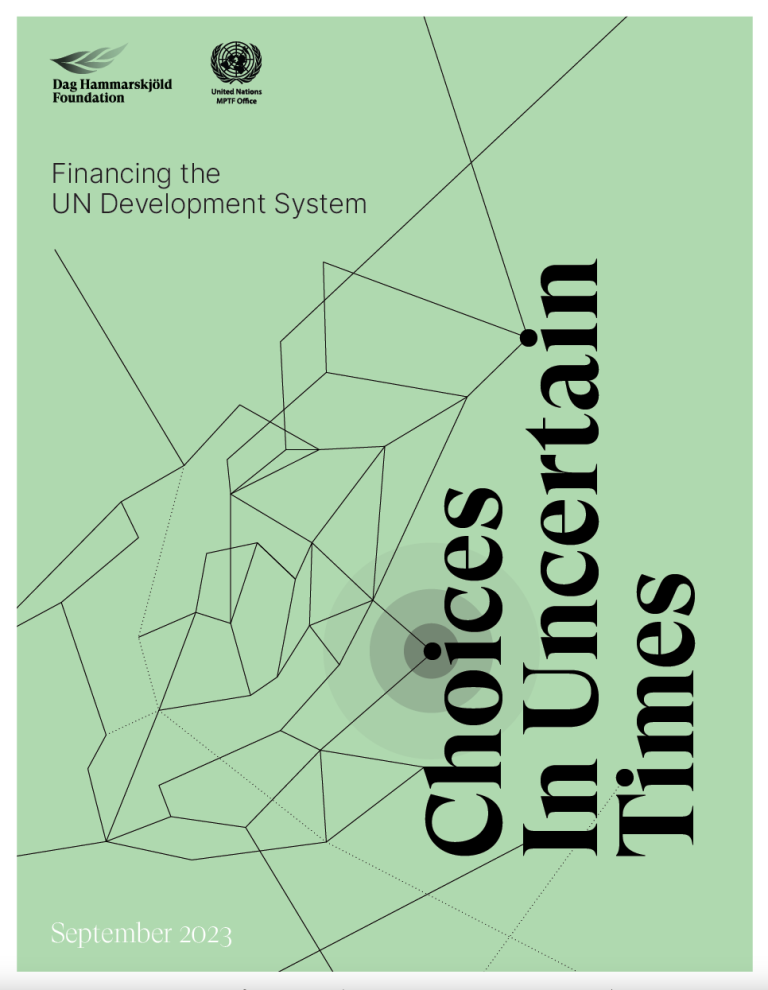Introduction
‘Localisation’ and ‘scale’ – two of the most dominant themes in recent development debates – are born of separate but related frustrations with the legacy and architecture of international development. In localisation’s case, this frustration begins with a rejection of the proposition that the wisdom and legitimacy to shape the destiny of a country, organisation, community or individual can come from the outside.
In the case of scaling, the frustration reflects a recognition that donor-funded projects and philanthropy are rarely, if ever, sufficient to produce sustainable development outcomes at scale. Although the constituencies and arguments in support of the movement supporting localisation and the movement supporting scaling continue to be quite separate, we argue that the two frustrations – and therefore the two movements – should be seen as flip sides of the same coin.
Localisation and local leadership
As currently used, the term ‘localisation’ encompasses three overlapping, yet distinct, objectives: enhancing the use of local institutions as implementing partners for donor projects; strengthening the capacity of local institutions; and advancing local ownership and leadership of the development process. Among these, the latter is by far the most fundamental, incorporating the first two objectives plus a sea of changes in the distribution of power.
The impetus for locally led development reflects a desire to effect a fundamental power shift that will nurture sustainability; prioritise the perspectives and preferences of national stakeholders like recipient governments, private businesses, civil society organisations, local communities and host country professionals; reflect current ethical sensibilities; and incorporate the voices of vulnerable groups. In the public sector, it implies moving from government ‘concurrence’ to genuine government ‘ownership’; while in the private sector, it implies moving from donor priorities to the priorities of communities, clients and consumers. Current discussion about ‘decolonising aid’ figures prominently in this debate.
While the focus on locally led development includes a clear differentiation between ‘local’ and ‘external’, it sometimes lacks comparable clarity about what constitutes ‘local’. Particularly in contexts where governments are authoritarian, corrupt or otherwise unaccountable, or where instability and identity-based conflict is prevalent, the concept of local voice and leadership can be fraught.
Similar challenges exist in settings where multi-national corporations or local elites have outsized influence. While observations about the central role of local leaders and local institutions in achieving results at scale are no less true in these settings, the crosswalk to an inclusive vision of locally led development is more complex.
Pathways to scale must pass through local leadership
One of the fundamental insights from over 20 years of research on scaling is that, with few exceptions, only governments and markets – often working together – have the capacity, resources and incentives to deliver goods, services and outcomes sustainably at scale.1 Philanthropy and donor-funded projects can contribute to these results only to the extent that they catalyse permanent changes in the actions of host governments, local markets or both, or by offering sustained support for a relatively small number of individuals unserved by established systems.
A related learning from research on scaling is the importance of identifying and cultivating the institutions that will serve as ‘doer’ and ‘funder’ at scale.2 In the case of a pure public service, government performs both roles. In the case of a purely commercial venture, the roles are performed by buyers and sellers.
In cases of subsidised service provision, it is often governments that provide some or all of the funding, while private firms or non-governmental organisations (NGOs) provide the service delivery. In addition, governmentally established policies play important roles in virtually all service delivery at scale. IImportantly, the concept of ‘local’ has deep significance and unique dynamics regarding the funding, leadership, management and accountability associated with each of these institutions.
We have, in other publications, identified a total of ten pathways to scale, distinguished in part by the role eventually played by the organisation that initiated the new product, practice or service (See Figure 1)
In the case of those pathways classified as Expansion, the originating organisation expands dramatically to match the scale of the need. In the pathways referred to as Replication, funding and operational responsibility are transferred to the government or other actors able to deliver, fund and sustain these changes at scale. And in the case of Collaboration pathways, the originating organisation remains involved but does so in partnership with other actors who make the funding and/or delivery at scale possible. All these pathways ultimately require local engagement, leadership, capacity and ownership if successful and sustainable scaling is to take place.
Scaling experience also suggests the essential role usually played by ‘intermediary organisations’ in facilitating the transition of improved practices from small to large scale. Analogous to venture capitalists and investment bankersin the private sector, these institutions perform functions such as investment packaging, convening, marketing and advocacy. But unlike analogous organisations in the private sector, these organisations face difficult business models in the public arena, and their absence in lower- and middleincome countries has been described as the ‘broken part of the business model’ in taking development outcomes to scale.
External actors, in particular United Nations agencies such as the UN Development Programme (UNDP), UN Environment Programme (UNEP), and UNICEF; international NGOs such as CARE and Catholic Relief Services (CRS); and large multilateral and bilateral funders such as the multilateral development banks, German Agency for International Cooperation (GIZ) and the United States Agency for International Development (USAID), have played the role of intermediaries, but their engagement has generally been limited in duration and not sufficiently focused on building local intermediation capacity. This is, however, beginning to change. Organisations such as CRS are now focusing precisely on this task.

The Scaling Community of Practice’s 2021 publication on scaling principles further details the role of local leadership based on lessons drawn from two decades of scaling research and practice, and as documented in a variety of case studies.5 These insights include:
• successful scaling requires a vision of a scale, long-term engagement, a viable business model, reliable funding, institutional capacity, and ongoing political commitment beyond the limited time horizon of individual projects;
• each of these factors in turn requires that local actors and organisations are committed to leading scaling through to success, willing to make decisions, and able to mobilise and coordinate others to support scaling goals, strategy and tactics;
• the intermediary role is generally best carried out by a national or local organisation but is often either ignored entirely or inadequately filled; and
• monitoring, evaluation and learning (MEL) needs to be participatory, with local interests and capacity fully engaged to ensure ownership, as well as effective learning and adaptation.
The obstacles to localisation and scaling are similar and best overcome by addressing the two issues together
Official donors and private philanthropies have undertaken a wide array of efforts in recent years to promote and enhance localisation, including the World Bank’s drive to end reliance on special project implementation units; UN agencies’ emphasis on local implementation; and actions by numerous funders to decentralise their administration, strengthen local consultation, and increase their reliance on local professionals and organisations.
In the view of many, however, these internal reforms have had limited impact in genuinely shifting power to local leaders and organisations. This is in part due to political and institutional realities whereby donor objectives and priorities combine with a perceived need to show quick disbursement and results while avoiding embarrassing failures or a breakdown in fiduciary standards. Collectively, these pressures create pervasive incentives to maintain traditional project and programme modalities, which include maintaining donor control over most aspects of the project cycle.6 These challenges are compounded in countries where political instability, endemic corruption and gaps in local institutional capacity have undermined donor trust in local leadership.
Similar factors undermine donor efforts to focus more systematically on scaling and militate against a longer-term perspective on supporting systemic change and creating the preconditions for successful, sustainable scaling of development interventions. These include reluctance to cede power to host country governments and private sector actors, combined with a focus on short-term project results, the one-off nature of project engagement for many donors (‘pilots to nowhere’), frequent shifts in donor priorities, rotation of donor personnel, and the employment of international implementing partners.
The strong links between localisation and scaling, and the implications of both for traditional donor practices, suggest the value of reframing objectives in terms of goods, services and outcomes delivered sustainably at population scale through local organisations able and willing to deliver them on a sustainable basis. Reconceptualised in this way, donor-funded projects and private philanthropy can assist and sometimes catalyse, but cannot substitute for, initiatives by these permanent local institutions – primarily governments and businesses, but also social enterprises, NGOs and community organisations – to create a ‘new normal’ through permanent changes they are financially able and willing to implement at scale and over time.
Although local resource mobilisation, local institutions and priorities sit in the centre of this formulation, potential contributions by external funders remain significant, particularly in providing the disposable resources needed to transition from established arrangements. In this regard, experience from the Scaling Community of Practice suggests the particular added value of reducing the risk to early adopters, advocating for supportive policy regimes and strengthening the intermediary functions needed to achieve the scaling of improved practices
While the headwinds remain considerable, a growing sense of urgency and anxiety about achievement of the SDGs and Paris Agreement climate targets is providing new incentives for tackling the scaling agenda in a meaningful way.8 Linking this imperative to the recent policy initiatives on localisation has the potential to bolster the resolve needed to overcome the obstacles blocking the path to both objectives. In that regard, there are important lessons to be learned from vertical funds such as the Global Fund and President’s Emergency Plan for AIDS Relief (PEPFAR) that have combined a systematic focus on sustainable scale with explicit efforts to engage on a long-term basis with, and recognise the leadership roles of, local institutions, officials and communities.
This is an article originally published in the Dag Hammarskjöld Foundation’s “Financing the UN Development System: Choices in Uncertain Times 2023” report.

You can download the individual article from the report here.




